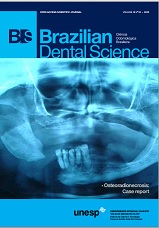Hemodynamic evaluation of normotensive and hypertensive patients undergoing dental extraction under local anesthesia with 3% prilocaine with felypressin
DOI:
https://doi.org/10.14295/bds.2015.v18i2.1117Resumo
Objective: this study evaluated hemodynamic variations of normotensive and hypertensive patients undergoing dental extraction under local anesthesia with 3% prilocaine with felypressin 0.03UI/ml. Material and Methods: 49 patients of the Department of Surgery and Maxillo-facial Traumatology ambulatory were evaluated, 30 normotensive and 19 hypertensive, presenting initial systolic blood pressure lower then 160 mmHg and diastolic blood pressure lower then 100 mmHg, besides being under medical supervision. Patients underwent molar or premolar extraction, typically deployed with maximum degree of mobility 2, according to Miller’s classification. The parameters evaluated were systolic and diastolic blood pressures and heart rate, using an automatic digital pulse device, in the following periods: T1 - initial (5 minutes before the beginning of surgery, T2 – post-anesthesia (2 minutes after anesthetic administration); T3 – trans-operatory (each 5 minutes after T2 until 20 minutes completition, totalyzing 4 trans-operatory mensurations); T4 – post-surgery (5 minutes after surgery). Results: statistical analysis showed that for the parameters systolic blood pressure (P = 0.959) and diastolic blood pressure (P = 0.754) no statistically significant difference for these parameters in different evaluation periods. The analysis of heart rate values showed no statistical difference (p <0.05) between the values obtained in T1 in hypertensive and normotensive patients in T3.3. Conclusion: it was concluded that the evaluated hemodynamic parameters varied in different periods evaluated in the group of normotensive and hypertensive patients, but did not differ significantly.
Downloads
Downloads
Publicado
Como Citar
Edição
Seção
Licença
TRANSFERÊNCIA DE DIREITOS AUTORAIS E DECLARAÇÃO DE RESPONSABILIDADE
Toda a propriedade de direitos autorais do artigo "____________________________________________________________________" é transferido do autor(es) para a CIÊNCIA ODONTOLÓGICA BRASILEIRA, no caso do trabalho ser publicado. O artigo não foi publicado em outro lugar e não foi submetido simultaneamente para publicação em outra revista.
Vimos por meio deste, atestar que trabalho é original e não apresenta dados manipulados, fraude ou plágio. Fizemos contribuição científica significativa para o estudo e estamos cientes dos dados apresentados e de acordo com a versão final do artigo. Assumimos total responsabilidade pelos aspectos éticos do estudo.
Este texto deve ser impresso e assinado por todos os autores. A versão digitalizada deverá ser apresentada como arquivo suplementar durante o processo de submissão.




























